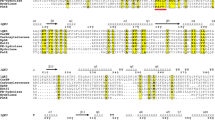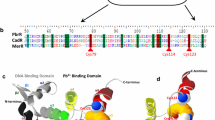Abstract
Peptide-displaying Escherichia coli cells were investigated for use in adsorptive removal of bisphenol A (BPA) both in Luria–Bertani medium including BPA or ATM thermal paper eluted wastewater. Two recombinant strains were constructed with monomeric and dimeric repeats of the 7-mer BPA-binding peptide (KSLENSY), respectively. Greater than threefold increased adsorption of BPA [230.4 µmol BPA per g dry cell weight (DCW)] was found in dimeric peptide-displaying cells compared to monomeric strains (63.4 µmol per g DCW) in 15 ppm BPA solution. The selective removal of BPA from a mixture of BPA analogs (bisphenol F and bisphenol S) was verified in both monomeric and dimeric peptide-displaying cells. The binding chemistry of BPA with the peptide was assumed, based on molecular docking analysis, to be the interaction of BPA with serine and asparagine residues within the 7-mer peptide sequence. The peptide-displaying cells also functioned efficiently in thermal paper eluted wastewater containing 14.5 ppm BPA.







Similar content being viewed by others
References
Michałowicz J (2014) Bisphenol A—sources, toxicity and biotransformation. Environ Toxicol Pharmacol 37:738–758
Rajasärkkä J, Koponen J, Airaksinen R, Kiviranta H, Virta M (2014) Monitoring bisphenol A and estrogenic chemicals in thermal paper with yeast-based bioreporter assay. Anal Bioanal Chem 406:5695–5702
Liao C, Kannan K (2011) Widespread occurrence of bisphenol A in paper and paper products: implications for human exposure. Environ Sci Technol 45:9372–9379
Geens T, Goeyens L, Kannan K, Neels H, Covaci A (2012) Levels of bisphenol-A in thermal paper receipts from Belgium and estimation of human exposure. Sci Total Environ 435–436:30–33
Porras SP, Heinälä M, Santonen T (2014) Bisphenol A exposure via thermal paper receipts. Toxicol Lett 230:413–420
Mendum T, Stoler E, VanBenschoten H, Warner JC (2010) Concentration of bisphenol A in thermal paper. Green Chem Lett Rev 4:81–86
Bae W, Wu CH, Kostal J, Mulchandani A, Chen W (2003) Enhanced mercury biosorption by bacterial cells with surface-displayed MerR. Appl Environ Microbio 69:3176–3180
Li P-S, Tao H-C (2013) Cell surface engineering of microorganisms towards adsorption of heavy metals. Crit Rev Microbio 41:140–149
Cruz N, Le Borgne S, Herna´ndez-Cha´vez G, Gosset G, Valle F, Bolivar F (2000) Engineering the Escherichia coli outer membrane protein OmpC for metal bioadsorption. Biotechnol Lett 22:623–629
Maruthamuthu M, Nadarajan S, Ganesh I, Ravikumar S, Yun H, Yoo I-k, Hong S (2015) Construction of a high efficiency copper adsorption bacterial system via peptide display and its application on copper dye polluted wastewater. Bioproc Biosyst Eng 38:2077–2084
Ravikumar S, Ganesh I, Yoo I-K, Hong SH (2012) Construction of a bacterial biosensor for zinc and copper and its application to the development of multifunctional heavy metal adsorption bacteria. Process Biochem 47:758–765
Maruthamuthu M, Ganesh I, Ravikumar S, Hong S (2015) Evaluation of zraP gene expression characteristics and construction of a lead (Pb) sensing and removal system in a recombinant Escherichia coli. Biotechnol Lett 37:659–664
Ravikumar S, Yoo I-K, Lee SY, Hong SH (2011) A study on the dynamics of the zraP gene expression profile and its application to the construction of zinc adsorption bacteria. Bioproc Biosyst Eng 34:1119–1126
Yoo I-K, Choe WS (2013) Screening of peptide sequences with affinity to bisphenol A by biopanning. Korean J Microbiol 49:211–214
Baslé A, Rummel G, Storici P, Rosenbusch JP, Schirmer T (2006) Crystal structure of osmoporin OmpC from E. coli at 2.0 Å. J Mol Biol 362:933–942
Eswar N, Webb B, Marti-Renom MA, Madhusudhan MS, Eramian D, Shen M-Y, Pieper U, Sali A (2001) Comparative protein structure modeling using MODELLER. Current protocols in protein science. Wiley, New Jersey
Laskowsky RAMM., Moss DS, Thornton JM (1993) PROCHECK: a program to check the stereo chemical quality of protein structures. J Appl Crystallogr 26:283–291
Ramachandran GNRC., Sasisekharan V (1963) Stereochemistry of polypeptide chain configurations. J Mol Biol 7:95–99
Bhattacharya D, Cheng J (2013) 3Drefine: consistent protein structure refinement by optimizing hydrogen bonding network and atomic-level energy minimization. Proteins 81:119–131
Wiederstein M, Sippl MJ (2007) ProSA-web: interactive web service for the recognition of errors in three-dimensional structures of proteins. Nucleic Acids Res 35:W407-W410
Patra SM, Baştuǧ T, Kuyucak S (2007) Binding of organic cations to gramicidin A channel studied with autodock and molecular dynamics simulations. J Phys Chem B 111:11303–11311
Salentin S, Schreiber S, Haupt VJ, Adasme MF, Schroeder M (2015) PLIP: fully automated protein–ligand interaction profiler. Nucleic Acids Res 43:W443-W447
Laemmli UK (1970) Cleavage of structural proteins during the assembly of the head of bacteriophage T4. Nat 227:680–685
Han W, Luo L, Zhang S (2012) Adsorption of bisphenol A on lignin: effects of solution chemistry. Int J Environ Sci Technol 9:543–548
Lazim ZM, Hadibarata T, Puteh MH, Yusop Z (2015) Adsorption characteristics of bisphenol A onto low-cost modified phyto-waste material in aqueous solution. Water Air Soil Poll 226:34
Endo Y, Kimura N, Ikeda I, Fujimoto K, Kimoto H (2007) Adsorption of bisphenol A by lactic acid bacteria, Lactococcus, strains. Appl Microbiol Biotechnol 74:202–207
Acknowledgements
This research was supported by the Basic Science Research Program through the National Research Foundation of Korea (NRF) funded by the Ministry of Education, Science, and Technology (2013R1A1A2004799).
Author information
Authors and Affiliations
Corresponding author
Rights and permissions
About this article
Cite this article
Maruthamuthu, M.k., Hong, J., Arulsamy, K. et al. Development of bisphenol A-removing recombinant Escherichia coli by monomeric and dimeric surface display of bisphenol A-binding peptide. Bioprocess Biosyst Eng 41, 479–487 (2018). https://doi.org/10.1007/s00449-017-1882-z
Received:
Accepted:
Published:
Issue Date:
DOI: https://doi.org/10.1007/s00449-017-1882-z




